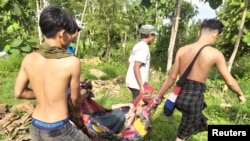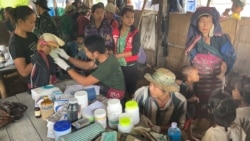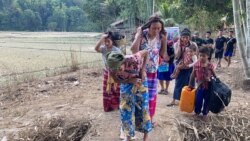The head of a volunteer aid group, speaking from inside Myanmar, has described increasing attacks by that country’s military in the ethnic areas along the country’s borders with China and Thailand.
Speaking to VOA by satellite phone Friday from northern Kayin state in Myanmar’s east, David Eubank, the head of the Free Burma Rangers, said since the February 1 coup, Myanmar’s military has not only attacked urban protesters but is now carrying out increasing offensives on the country’s fringes.
The United Nations said last month that almost a quarter of a million people have been driven from their homes and villages by post-coup violence, and that millions risk hunger in coming months. Most of them are spread across the border areas, where ethnic minorities with standing armies have been fighting the military for autonomy for decades. Eubank’s Free Burma Rangers sends hundreds of volunteers into Myanmar’s conflict zones with medical services and supplies — from rice to schoolbooks — for remote rural areas.
‘The gloves came off’
“Once the coup happened,” Eubank said, “it was like the gloves came off the Burma military. Not only did they begin to crush the people in the streets, as you’ve seen; they began to unleash their power on the ethnics, and that’s when we saw this huge uptick of attacks and displacement.” Myanmar is also known as Burma.
When the military started attacking targets in northern Kayin after the coup, by air for the first time in decades, the area’s displaced population jumped tenfold from 4,000 to 40,000 by April, Eubank said.
He estimated the airstrikes have killed about 20 civilians in the area and wounded some 40 more. He said that is fewer than those killed by the military’s ground forces in northern Kayin, which he puts at about 40, “but the psychological impact of the airplanes is just huge up here.”
“Way past the killing that the airstrikes [caused] and damage they did has been the fear,” he said.
Myanmar government officials could not be reached for comment. In the past the military has said it has only uses proportionate force against threats to state security.
In the jungle
Eubank said most of the 40,000 have returned home in recent weeks as the airstrikes died down and most of the new troops the military moved in were pulled back, although skirmishes with forces of the Karen National Union, one of the country’s many armed ethnic groups, have kept up.
He said the most intense fighting since the coup is in the northernmost state of Kachin, where the military has been losing ground to the Kachin Independence Army, another ethnic armed group.
In the past few weeks, though, fighting has picked up most in the tiny eastern state of Kayah, also known as Karenni, where the military is up against smaller militias and new “people’s defense forces” of locals who have pooled their weapons to resist the junta. Fighting there has driven more than 100,000 people out of their homes, now the most in any state or region, Eubank, who has teams there, said.
Those teams, he said, report soldiers looting villagers’ homes and firing into the jungle with rifles and rocket-propelled grenades, both to keep any rebels at bay and to clear tracts of land of anyone else.
“I’m looking at photos that my team sent right now. … I see wrecked houses. I’m looking at a destroyed church. I’m looking at a guy who was shot. I’m looking at pictures of IDPs [internally displaced persons] hiding in the jungle,” he told VOA.
Heavy rains have only made it worse for those pushed into the jungle, he added, with many reduced to catching frogs and hunting squirrels to supplement their rice.
Those who can, find caves, the rest make due under pitched tarps, or less, Eubank said.
“Very often they fled out of the house with just what they could carry and maybe had a sheet of plastic over their shoulders. So maybe they’ll cut bamboo and make a frame, like a lean-to frame, and then lay banana leaves and other leaves over it to make a little shelter and huddle under that,” he said.
“They live pretty rough. And then there’s no school, and they’ve got the clothes on their back. And if there’s hundreds of them on the same stream. then you have pollution problems and dysentery.”
A looming crisis
Eubank said the military was also setting up checkpoints and sending out patrols to keep aid shipments from flowing from the plains into the hills and rebel-controlled areas, where many of the displaced are taking shelter, checking people for everything from extra food and medicine to batteries and children toys.
He said supplies were still getting in and that most of the newly displaced have enough rice right now and to last the next two to three months.
Even those who have felt safe enough to return home, though, as in Kayin, are a month or two behind on their farming and coming back to overgrown fields that need extra work, he added. That could mean much less rice at harvest time.
Some of those who have returned are also still under fire, he said.
Eubank said he came across a woman in Kayin a few weeks ago being shot at with automatic and sniper rifles from the surrounding hills while planting her rice field. Determined to get the job done, he said, she gathered up her neighbors and together they finished the planting that night in the dark.
The 100,000 still living rough in Kayah cannot even do that. Last month the U.N.’s special rapporteur on human rights in Myanmar, Thomas H. Andrews, warned of “mass death” among the displaced there from starvation, disease and exposure if the military continued to cut them off from critical supplies.
Eubank said that could come to pass if more aid does not get in and if they cannot move to where they can find what they need to survive.
“I think it’s a big risk if this goes on, especially for right now in Karenni,” he said. “We have these 100,000 people, and we’re moving literally tons of rice up there through a variety of means. But that’s not sure to meet all the needs. And if the Burma army continues the pressure against those 100,000, they’re going to have to move or they’re going to starve to death,” he said.
The junta claims it toppled the country’s civilian government because it had ignored reports of widespread irregularities in last year’s general elections, in which the military’s proxy party was soundly defeated, but has shown no evidence to back it up. State media now run by the junta has blamed the crisis that has followed the coup on “dishonesty of democracy” in the election.













